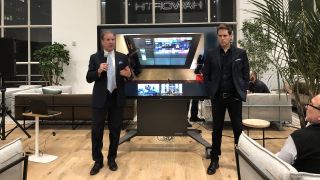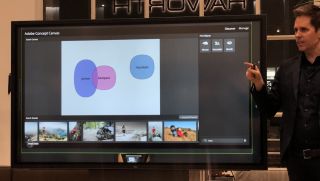If you’re anxious about a future in which artificial intelligence (AI) will render humans obsolete, you can relax a little. “It’s still about the human condition, and technology will serve to amplify it,” said Chris Duffey, strategic development manager at Adobe. “It’s going to take away the grunt work; it’s not going to replace humanity and the need for human creativity and innovation.”

On Tuesday, January 22, collaboration software company Bluescape hosted a gathering on the future of creative workplaces with partner Adobe at the New York Haworth Showroom Creativity Center. After some networking over cocktails and hors d’oeuvres, Bluescape’s CEO Peter Jackson welcomed attendees and opened the night’s discussion on how Adobe’s integration of AI into its software suite is enhancing the speed of creativity and innovation, and how adding this power to Bluescape’s digital workspace platform is transforming the process of visionary teamwork.
“The time to start a meeting, the time to get everyone involved in a project is being cut dramatically by collaboration technologies,” Jackson said. “And if you add AI to that, you’re going to find that you’re going to get your creatives done faster, your projects done faster—hence, saving billions of dollars and harvesting billions of dollars more in revenue.”
After some background on the history of AI and intelligent assistants, Duffey introduced Adobe Sensei, an AI platform embedded into all of the company’s software. “It’s our framework, it’s our platform that’s comprised of an ensemble of different techniques to achieve everything from creating content more intelligently, to distributing it more intelligently, to measuring it more intelligently,” he said.
Duffey provided examples of this integration, beginning with Adobe Stock, one of the company’s new offerings. Here, Sensei helps users find content from the company’s stock media catalog faster using “visual search,” which works like a reverse Google image search, finding similar imagery based on an uploaded reference photo. In addition, Sensei can provide real-time metatagging of still and moving images to help companies organize their own media archives.
Perhaps the most interesting application—and one that Duffey said has him “geeking out as a former creative director”—is Adobe Concept Canvas, which is designed to help people ideate in real time. Users can search the Adobe Stock catalog by populating a canvas with rudimentary forms. For example, the user drags a circle labeled “person” to the left third of the canvas. The software then populates a bar below it with images featuring a person on the left third of the photo. He then adds a circle labeled “backpack” to the person, and “mountain” to the right side of the canvas—and the bar refreshes with imagery of people with backpacks in mountainous scenes.

“This is a deeper reference to how AI has moved up from an assistant, from a peer, to now, as a muse,” Duffey said. But ultimately, he opined, solutions like Adobe Sensei will transform more than just artistic pursuits; it will aid all creative people in coping with the reality of modern work. “We coined the term ‘content velocity’: the need to create more content faster, with fewer people and less resources. And this is where AI can be a huge asset across any industry and any challenge.”
For platforms like Bluescape—a software solution that brings groups in meeting rooms and remote workers together to collaborate on a shared, persistent workspace—the benefits are numerous. This is why the companies partnered to create a Bluescape plugin for Adobe Creative Cloud that enables teams to work collectively in applications like Adobe Illustrator, Photoshop, InDesign, and XD. And with Adobe Sensei, these collaborative sessions are made even more intelligent.
“Imagine where AI is in the background, analyzing, interpreting what’s happening in the collaboration environment, and now being able to distribute that across all of your teams,” Duffey said. “We now have the ability for anyone, at any time, at any level to be creative within the Bluescape environment. It’s ushering in the age of experimentation—we now need everyone to be creative and innovative.”










